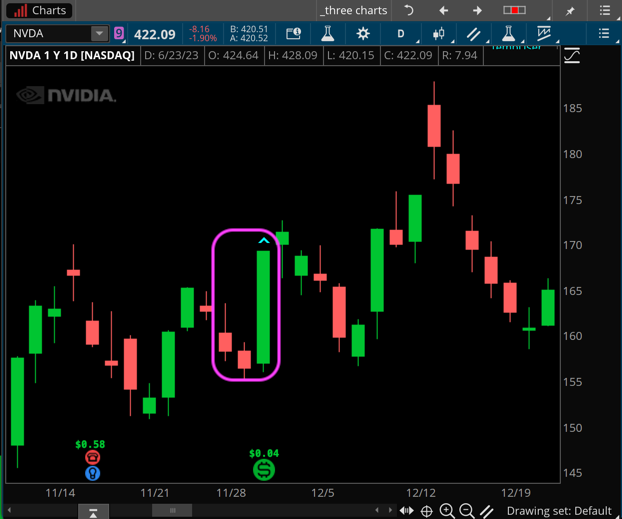| ♥ 0 |
Hello Can someone convert below TC2000 to Thinkorswim? L>L1 AND H>H1 and L1<L2 and H1 <H2 and O<L +((H-L)*0.30) AND C>H-((H-L)*0.30) AND H – L >= 3 * MAX(H1 – L1, 3) Thanks RESOLVED
Marked as spam
|
|
Private answer
I'm pretty sure I have this worked out. It would have been very helpful if you had included an example of this pattern from the charts so I had something to use for validating my solution. Since you did not, I strongly suggest you test this out before using it. I have included the original TC2000 formula elements as comment lines so you can see how that formula was translated into Thinkorswim. The variable names are intended to further explain what each section of the formula is measuring. I have included a screenshot below showing an example of this pattern on the chart. The pattern involves three candles and I have marked them with a magenta colored box.
First up, you need to know how to create a MTF scan: You will find that it is very simple. Just add another Study Filter to your scan and set the time frame to whatever higher time frame you want to use. Once you get that second study filter added, you can build your "bullish trend" using the Condition Wizard. No coding required, just a few clicks of the mouse. For the condition, you might chose something like Or if you are feeling very adventurous, you may consider browsing existing solutions in our stock scanners topic, and try someone else's idea of a bullish condition. The following link shows the results for the search term "bullish" in our stock scanners topic: I assure you if you take the time to learn how to master these tools your mind will be free to dream up an unlimited number of possibilities. But you need to invest the time in learning the tools, and how all the pieces fit together. If you don't feel you are getting the most from the scan tools on Thinkorswim, be sure to check out our master class on the topic: Thinkorswim Scans Beginner to Advanced Marked as spam
|
Please log in to post questions.

